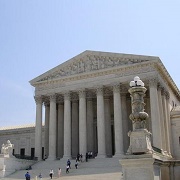Health Insurance Company Couldn’t Lay Claim to Personal Assets
The Supreme Court’s decision found that the health insurance company could not sue Montanile for the settlement funds because they had already been spent.

- The health payer industry has seen its share of legal battles when it comes to keeping businesses afloat financially. One particular health insurance company – the National Elevator Industry Health Benefit Plan – paid $120,000 in medical expenses Robert Montanile, a man who was injured in a drunk driving accident.

Montanile sued the drunk driver in court and obtained a settlement of $500,000 of which half was taken in attorney fees. The ERISA plan claimed that any third party settlements were assets of their health insurance company, which entitled them to take the individual to court to claim their financial assets. This particular case went to the Supreme Court.
The Supreme Court’s decision found that the health insurance company could not sue Montanile for the settlement funds because they had already been spent. Therefore, any pursuit of funds would come directly from Montanile’s personal assets, which was unfounded under the law. To hear more about this particular court case, HealthPayerIntelligence.com spoke with Michael Graham, a partner with McDermott Will & Emery and co-chair of the firm’s ERISA Litigation Affinity Group, about Montanile v. Board of Trustees of the National Elevator Industry Health Benefit Plan.
“This is now the fourth Supreme Court case addressing the same general fact pattern and it’s the typical health plan segregation or reimbursement fact pattern,” Graham began. “What you have is a benefit plan participant who’s injured in an auto accident and then receives medical treatment and has those medical costs covered by the health plan.”
“Then the individual receives a settlement or a judgement from the third party wrong-doer. When they receive that settlement amount, the benefit plan typically has a reimbursement right to assert against the plan participant for the benefits paid because, if the plan participant receives a settlement or judgment covering that medical damage, they would receive a double recovery if they received both the settlement and their benefits for the injuries. So, there is ageneral obligation for plan participants to pay back the plan or reimburse the plan for the benefits that were paid when a settlement or judgment is received.”
 “This case follows the general fact pattern,” Graham continued. “A plan participant for the National Elevator Industry Health Benefit Plan was injured in an auto accident by a drunk driver. The plain paid $121,000 in medical benefits and he received a $500,000 settlement from the drunk driver’s insurance company. The participant’s attorney held those funds.”
“This case follows the general fact pattern,” Graham continued. “A plan participant for the National Elevator Industry Health Benefit Plan was injured in an auto accident by a drunk driver. The plain paid $121,000 in medical benefits and he received a $500,000 settlement from the drunk driver’s insurance company. The participant’s attorney held those funds.”
“The plan provided notice of their lien to the benefits that were paid. The attorney rejected that reimbursement request and then gave notice to the plan administrator that they needed to reach a settlement on the reimbursement amount. Otherwise, the attorney was going to release the full settlement amount to the participant.”
“The plan did not respond to that request and the attorney released the entire amount to Mr. Montanile. He then used that money to pay life expenses and dissipated some or all of the fund. The plan’s administrator then filed a lawsuit under ERISA 502(a)(3) seeking to recover equitable relief to enforce the plan’s reimbursement right against that settlement for the amount of benefits paid.”
“Ultimately, the argument that Montanile came back with was, ‘I spent all that money and, therefore, you cannot trace that money to any fund. You’re just seeking to get legal damages from me out of my general assets. Therefore, you can’t recover that lien.’”
“The court addressed its prior cases and noted that there is a two-part test to determine if a claim that is considered equitable in nature. One – the basis of the plaintiff’s claim must be equitable and – two – the nature of the underlying remedies sought must be equitable. In this case, it wasn’t a question as to whether the basis of the claim was equitable, but whether the remedy against the general assets of the defendant was equitable in nature.”
“The court found that the relief sought was not equitable. Applying the law from the old equity courts, if someone tried to enforce an equitable lien against a party’s general assets without tracing to a specific amount that they were trying attach the lien on, they were not permitted relief in the courts of equity.”
“Because there was no evidence that the plan could trace the equitable lien to actual monies held by Mr. Montanile through the settlement fund, the court remanded the case to make the determination of whether or not the monies could be traced amongst Mr. Montanile’s assets, and found that such a determination had not yet been made.”
 “While the case appears to favor employees, all is not lost for fiduciaries’ side,” he clarified. “Justice Thomas actually provided a couple of areas where this decision could be useful for plan administrators and fiduciaries when trying to recover their equitable liens or reimbursement amounts.”
“While the case appears to favor employees, all is not lost for fiduciaries’ side,” he clarified. “Justice Thomas actually provided a couple of areas where this decision could be useful for plan administrators and fiduciaries when trying to recover their equitable liens or reimbursement amounts.”
“One – he found that if the assets of the settlement fund are put into a comingled account and the fiduciary can trace the money into that account, then the equitable lien will attach against the account itself even if there is no direct evidence that the same money from the settlement still exists in that account. The Comingled account will allow for the equitable lien to proceed.”
“The second part is that, if they use monies in the account where the settlement funds were paid are traceable to the purchase of a car or a home, then those would be traceable assets could be attached by the equitable lien,” Graham explained.
How ruling affects health plans
“I think the decision is going to encourage benefit plan fiduciaries to take action on the reimbursement rights more quickly than they used to, to preserve their right to assert these equitable remedies against identifiable and traceable funds,” he mentioned.
“The sooner that the fiduciaries act, the better the chance that the settlement funds will actually be traceable and not dissipated by the participant,” he continued. “The plan administrators will likely look to strengthen their reimbursement and segregation provisions in the plan documents to require participants to provide more timely notice of when third party settlements are recovered so that they will know when there is a fund that is identifiable and traceable to recover a reimbursement right against.”
“tThe third result of the decision that may result is a new round of litigation on these reimbursement and segregation rights to determine what constitutes comingling in an identifiable and traceable account and also what assets will be deemed to be traceable like a car or a home,” he clarified.
“Like any good Supreme Court case, it provides guidance on the issue involved, but also creates additional litigation both by plan fiduciaries as well as plan participants to try to drill down further on what it really means to have an equitable remedy in these situations.”
Reasons for Supreme Court’s decision
When asked what the reasoning was behind the court’s decision to not allow the health insurance company to sue Montanile for the funds he already spent, the attorney replied, “What the court found was that there was a question of whether the settlement fund was traceable. Because there was not any evidence offered, so far, to determine whether the entire fund was spent by Mr. Montanile, the Court remanded the case back to the district court to see if the plan can prove that the funds are traceable and identifiable.”
“On remand, it will likely require a deposition of the participant or written discovery or both to discover where the money is traceable or has been dissipated,” Graham concluded.
The impact on future court cases
When asked how this ruling affects future injury cases between consumers and health insurers, Graham answered, “I think it will impact future cases by requiring fiduciaries to act much more quickly to enforce those reimbursement and segregation rights while the funds are still identifiable and traceable.”
“On the other side, it will encourage participants, when they receive their third party settlement funds, to spend them more quickly or to somehow make them less traceable for purposes of trying to avoid the attachment of an equitable lien. These issues will likely be the subject of the next round of litigation on these claims,” he concluded.
